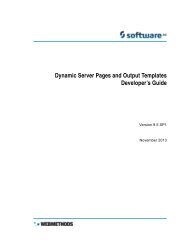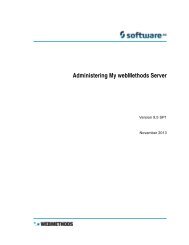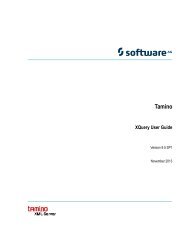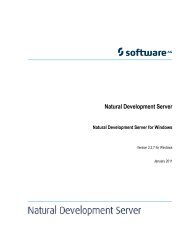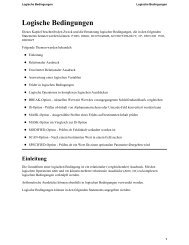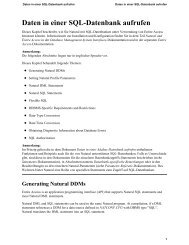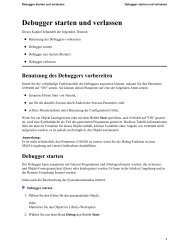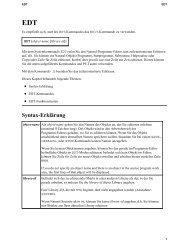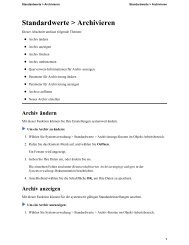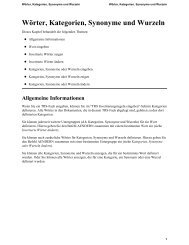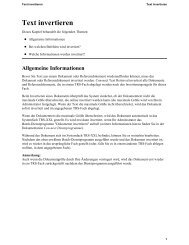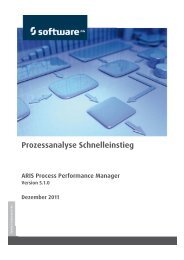Software AG IDL Editor - Software AG Documentation
Software AG IDL Editor - Software AG Documentation
Software AG IDL Editor - Software AG Documentation
Create successful ePaper yourself
Turn your PDF publications into a flip-book with our unique Google optimized e-Paper software.
output_substitution_sequence<br />
Syntax<br />
Sequence<br />
%after<br />
%Alias<br />
%before<br />
%Count<br />
%direction<br />
Meaning<br />
Inserts the digits after the decimal point of the current parameter (see<br />
simple-parameter-definition) into the output.<br />
This substitution sequence can only be used in an active loop_over_parameters,<br />
and if the current parameter is of data type N, NU, P, PU. Using it with other data<br />
types will lead to an error<br />
If a library alias name is used, inserts the library alias name of the current library<br />
(see library-definition) into the output. If no alias is provided, the library name<br />
(contents of %library) is provided in the %Alias substitution sequence. This<br />
substitution sequence can only be used in an active loop_over_libraries.<br />
Inserts the digits before decimal point of the current parameter (see<br />
simple-parameter-definition) into the output.<br />
This substitution sequence can be used only in an active loop_over_parameters,<br />
and if the current parameter is of data type N, NU, P, PU. Using it with other data<br />
types will lead to an error.<br />
Inserts the output's current line number. The format is controlled by the<br />
definition-of-names-format-template.<br />
Inserts the direction of the current parameter (see parameter-data-definition) into<br />
the output as specified with definition-of-direction-template. This substitution<br />
sequence can only be used in an active loop_over_parameters.<br />
%eLength Inserts the logical length of the current parameter (see simple-parameter-definition)<br />
into the output. This substitution sequence can only be used in active<br />
loop_over_parameters. The logical length according to the <strong>Software</strong> <strong>AG</strong> <strong>IDL</strong> data<br />
type is as follows:<br />
<strong>Software</strong> <strong>AG</strong> <strong>IDL</strong> <strong>Editor</strong><br />
for type A,K,B,I,F,U<br />
for type AV,KV,BV,UV<br />
for type L<br />
for type N,NU,P,PU<br />
for type T<br />
logical length as set in the <strong>IDL</strong> file<br />
Grammar for <strong>IDL</strong> Template Files<br />
maximum logical length as set in the <strong>IDL</strong> file<br />
Type L has no explicit logical length in the <strong>Software</strong><br />
<strong>AG</strong> <strong>IDL</strong> file. However, the length is always set to 1.<br />
Digits before and after decimal point in encoded form<br />
as given in the <strong>Software</strong> <strong>AG</strong> <strong>IDL</strong> file. Use the macro<br />
ERX_GET_DIGITS (see erx.h) to get the digits before<br />
the decimal point. Use the macro<br />
ERX_GET_DECIMALS (see erx.h) to get the number<br />
of digits after the decimal point.<br />
Type T has no explicit logical length in the <strong>Software</strong><br />
<strong>AG</strong> <strong>IDL</strong> file. However, the length is always set to 12.<br />
99



